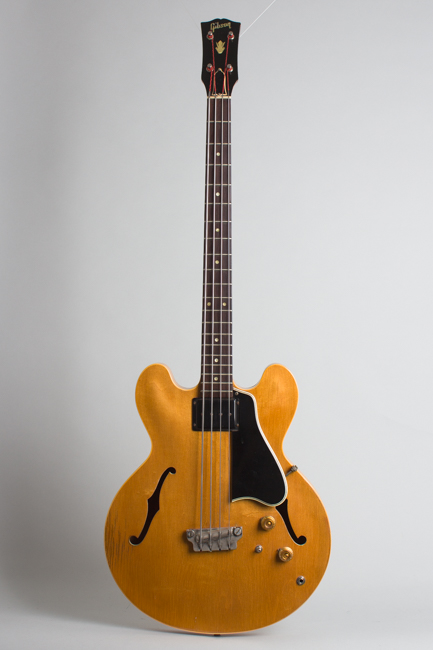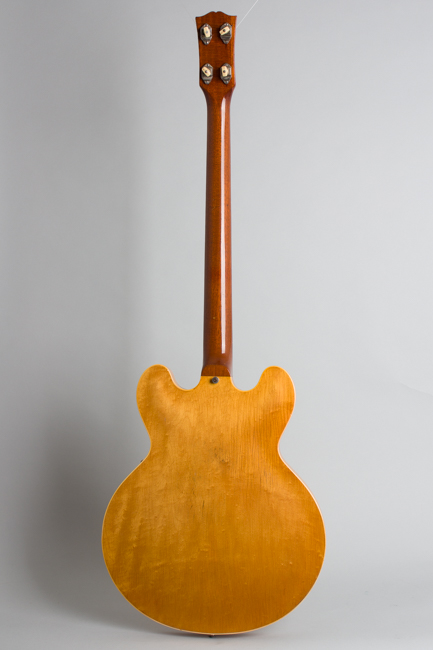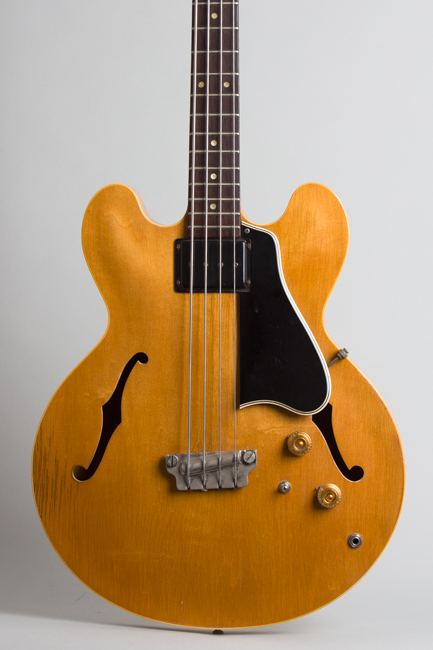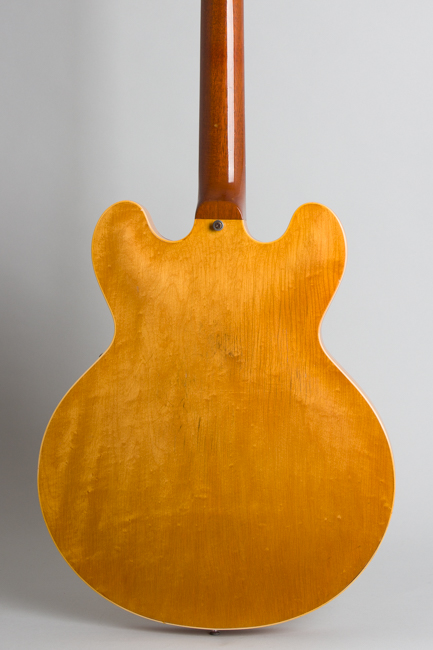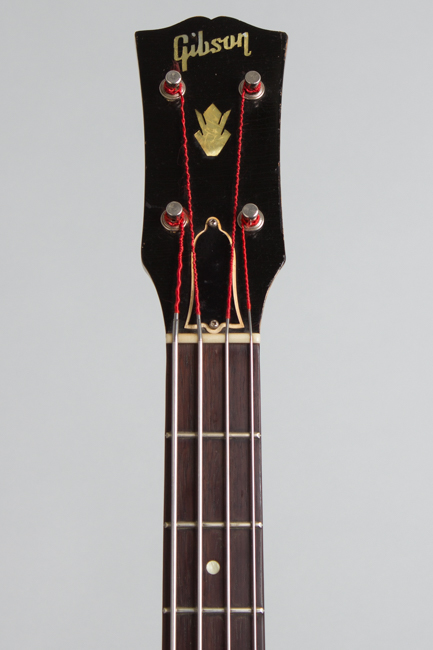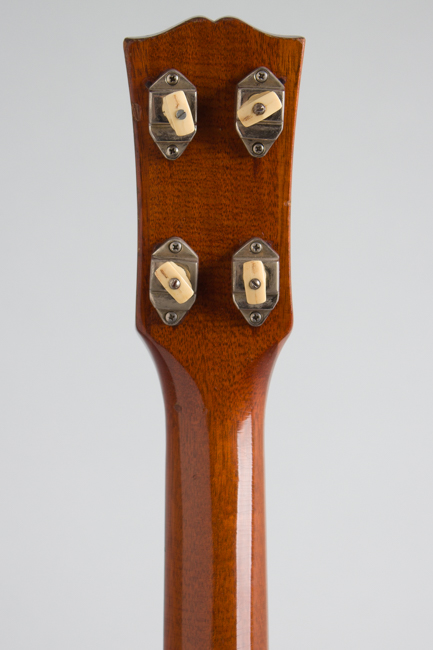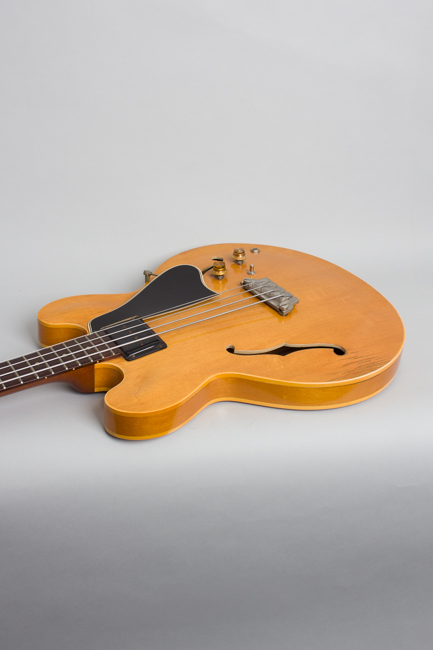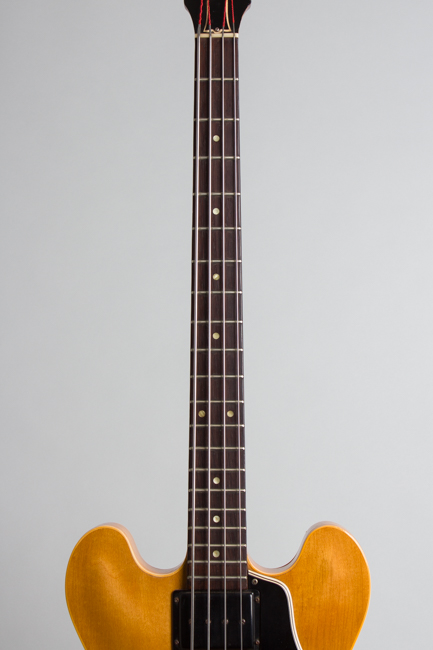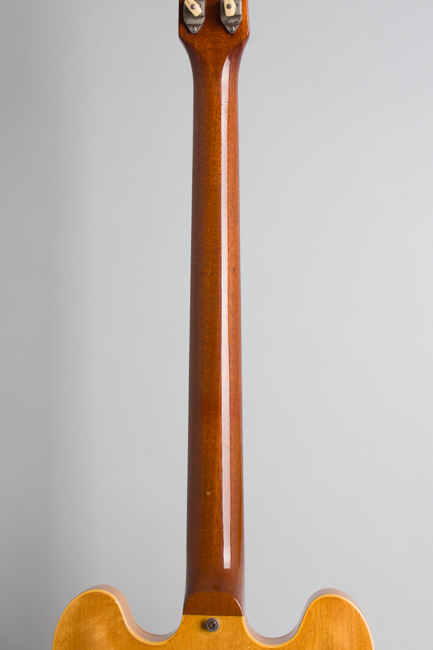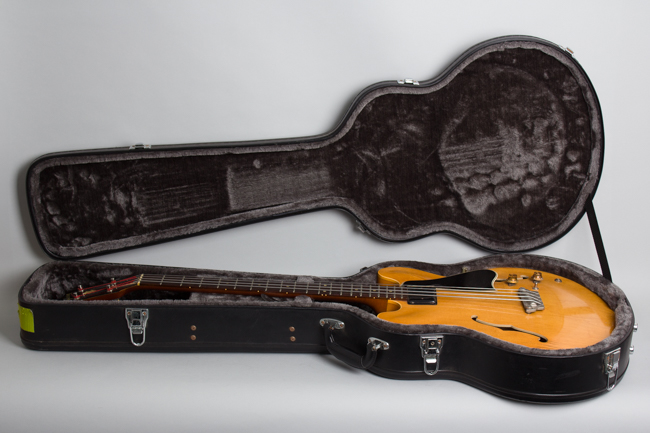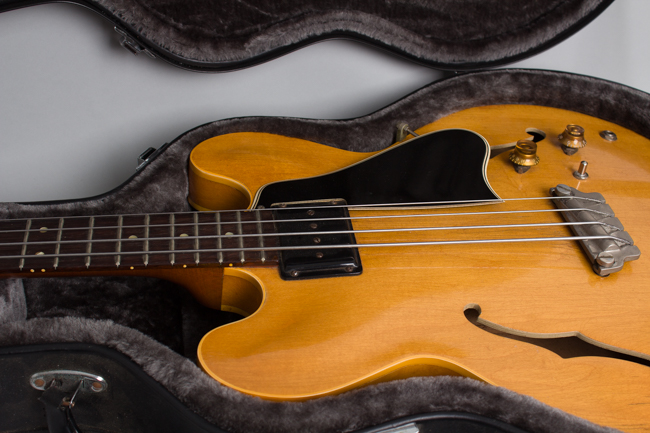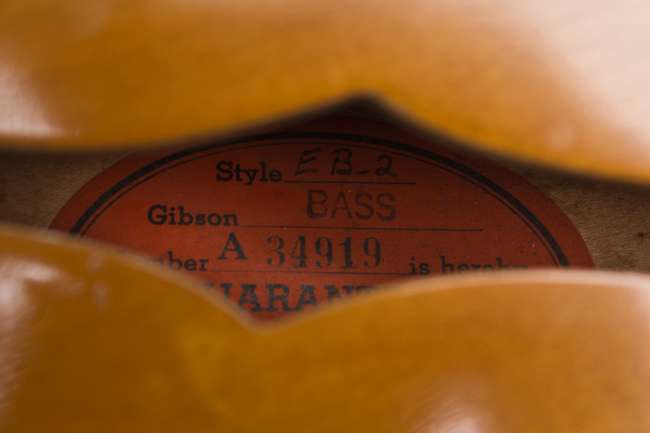Gibson EB-2N Electric Bass Guitar (1959)
Gibson EB-2N Model Electric Bass Guitar (1959), made in Kalamazoo, Michigan, serial # A-34919, natural lacquer finish, laminated maple body, mahogany neck with rosewood fingerboard, black tolex hard shell case.
This is a lovely original example of one of the rarest of all Gibson electric basses: the first-generation semi-hollow EB-2N in natural finish. The EB-2 in general is not a overly rare bass, but the first models built from 1958-61 were sold in relatively small numbers; many more were built in 1964-68 when production was at its peak. The Blonde ES-335 guitar from 1959 is one of Gibson's most treasured and sought after instruments; this matching companion bass is actually even rarer, if not as highly in demand!
The EB-2 first appeared in Gibson's catalogs in 1958, the initial companion piece for the new ES-335 guitar. It was offered in sunburst or natural finish, but the premium blonde model proved noticeably less popular. The list price in November 1959 was $300 (plus case), making it one of the most expensive of the limited number of electric basses in production before the dawn of the 1960s. This was oddly enough $5 more than a natural finish ES-335 and a $15 upcharge from the sunburst EB-2. As a result only 60 EB-2N's shipped 1959 and all of 90 were sold in total before the EB-2 was officially discontinued in 1961. Although it would return to the line in 1964 blonde would never again be a catalog option.
It seems likely much of Gibson's slow-selling stock of these 1961-2 was "dumped" overseas, primarily sent to Gibson's newly engaged distributor Selmer in the UK. Over the next two years the instrument became very popular with many emerging "Beat Group" players of the British Invasion era leading to re-orders and a return to production in 1963-4. Over the next few years production totals ramped up dramatically, but the like the matching guitars finish options were limited to sunburst or cherry.
This bass has all the classic 1959 features: a gleaming natural finish on the laminated maple body, nickel plated hardware including the heavy cast bridge, gold plastic knobs, no mute assembly or handrest and a medium-chunky round backed neck. This 1959 bass has the "Tone Modifier" (choke) pushbutton added that year enabling players to limit the sometimes amp-challenging output of the large humbucking pickup. This is set under a black plastic cover, another distinctive feature of the early models along with backwards-facing banjo tuners on the slimmer headstock.
This bass is a breed apart from the fairly common later 1960s EB-2's and one of the rarest and coolest heavy thump machines out there! A large proportion of professional UK acts used versions of this model bass or its Epiphone doppelganger, the Rivoli in the first years of the British invasion. This early one still delivers the essential tones for the Animals, Yardbirds, Manfred Mann and beyond! Wes Hunter of UK's Sounds Incorporated used a 1959 EB-2 identical to this one to back up many top vocal acts of the 1960s, and there are even pictures of sir Paul McCartney trying it out (the bands often played together on 1960s UK tour bills). Natural 1959 EB-2s like this rarely turn up at all, and this is a splendid example.
Overall length is 44 3/4 in. (113.7 cm.), 16 1/4 in. (41.3 cm.) wide at lower bout, and 1 3/4 in. (4.4 cm.) in depth, measured at side of rim. Scale length is 30 1/2 in. (775 mm.). Width of nut is 1 11/16 in. (43 mm.).
This bass has seen some use and shows fairly light wear for 65+ years on the planet but remains a very nice example of a blonde EB-2. It is completely original except for the two knobs, with no repairs or alterations. The all-original finish has ambered and shows moderate checking while the nickel bridge hardware shows typical tarnish. The are small dings, scratches and dents overall, with a small area of flaking finish in the area of the top where the player's arm rests but really this is a pretty clean bass. The knobs are "close but no cigar"; one is a correct repro, the other a '60s gold capped version lacking the cap. Of course this could be remedied without too much hassle back to all-original style fittings if desired.
The electronics including the sometimes cranky 2-way baritone switch perform exactly as they should. This bass is strung with flatwound strings as it likely has largely been since new leaving the frets looking little worn. A real minimalist blonde beauty this is visually simply a 4-string stunner and plays exactly as it did in 1959, with a huge room filling thump which can be cut to a tighter klunk in the "baritone" position. It resides in a modern HSC. Overall Excellent - Condition.
This is a lovely original example of one of the rarest of all Gibson electric basses: the first-generation semi-hollow EB-2N in natural finish. The EB-2 in general is not a overly rare bass, but the first models built from 1958-61 were sold in relatively small numbers; many more were built in 1964-68 when production was at its peak. The Blonde ES-335 guitar from 1959 is one of Gibson's most treasured and sought after instruments; this matching companion bass is actually even rarer, if not as highly in demand!
The EB-2 first appeared in Gibson's catalogs in 1958, the initial companion piece for the new ES-335 guitar. It was offered in sunburst or natural finish, but the premium blonde model proved noticeably less popular. The list price in November 1959 was $300 (plus case), making it one of the most expensive of the limited number of electric basses in production before the dawn of the 1960s. This was oddly enough $5 more than a natural finish ES-335 and a $15 upcharge from the sunburst EB-2. As a result only 60 EB-2N's shipped 1959 and all of 90 were sold in total before the EB-2 was officially discontinued in 1961. Although it would return to the line in 1964 blonde would never again be a catalog option.
It seems likely much of Gibson's slow-selling stock of these 1961-2 was "dumped" overseas, primarily sent to Gibson's newly engaged distributor Selmer in the UK. Over the next two years the instrument became very popular with many emerging "Beat Group" players of the British Invasion era leading to re-orders and a return to production in 1963-4. Over the next few years production totals ramped up dramatically, but the like the matching guitars finish options were limited to sunburst or cherry.
This bass has all the classic 1959 features: a gleaming natural finish on the laminated maple body, nickel plated hardware including the heavy cast bridge, gold plastic knobs, no mute assembly or handrest and a medium-chunky round backed neck. This 1959 bass has the "Tone Modifier" (choke) pushbutton added that year enabling players to limit the sometimes amp-challenging output of the large humbucking pickup. This is set under a black plastic cover, another distinctive feature of the early models along with backwards-facing banjo tuners on the slimmer headstock.
This bass is a breed apart from the fairly common later 1960s EB-2's and one of the rarest and coolest heavy thump machines out there! A large proportion of professional UK acts used versions of this model bass or its Epiphone doppelganger, the Rivoli in the first years of the British invasion. This early one still delivers the essential tones for the Animals, Yardbirds, Manfred Mann and beyond! Wes Hunter of UK's Sounds Incorporated used a 1959 EB-2 identical to this one to back up many top vocal acts of the 1960s, and there are even pictures of sir Paul McCartney trying it out (the bands often played together on 1960s UK tour bills). Natural 1959 EB-2s like this rarely turn up at all, and this is a splendid example.
Overall length is 44 3/4 in. (113.7 cm.), 16 1/4 in. (41.3 cm.) wide at lower bout, and 1 3/4 in. (4.4 cm.) in depth, measured at side of rim. Scale length is 30 1/2 in. (775 mm.). Width of nut is 1 11/16 in. (43 mm.).
This bass has seen some use and shows fairly light wear for 65+ years on the planet but remains a very nice example of a blonde EB-2. It is completely original except for the two knobs, with no repairs or alterations. The all-original finish has ambered and shows moderate checking while the nickel bridge hardware shows typical tarnish. The are small dings, scratches and dents overall, with a small area of flaking finish in the area of the top where the player's arm rests but really this is a pretty clean bass. The knobs are "close but no cigar"; one is a correct repro, the other a '60s gold capped version lacking the cap. Of course this could be remedied without too much hassle back to all-original style fittings if desired.
The electronics including the sometimes cranky 2-way baritone switch perform exactly as they should. This bass is strung with flatwound strings as it likely has largely been since new leaving the frets looking little worn. A real minimalist blonde beauty this is visually simply a 4-string stunner and plays exactly as it did in 1959, with a huge room filling thump which can be cut to a tighter klunk in the "baritone" position. It resides in a modern HSC. Overall Excellent - Condition.
